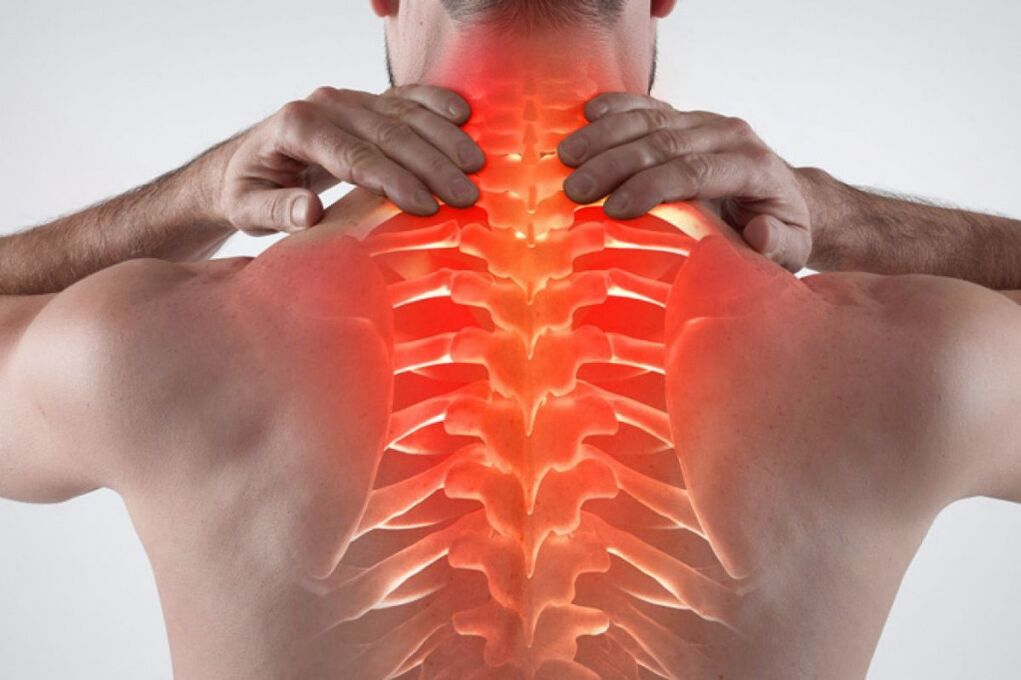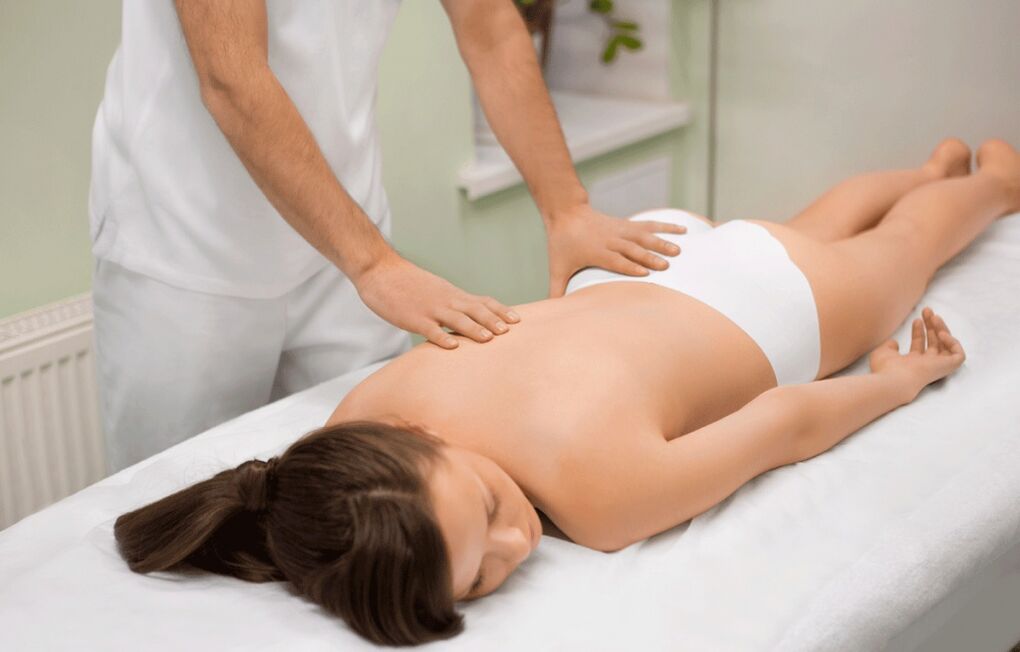
Thoracic osteochondrosis is a degenerative disease of the thoracic spine. First of all, the disease affects the intervertebral discs, which causes back pain and unpleasant symptoms. Premature "aging" of the cartilage tissue of the disc is also characteristic of the disease.
Osteochondrosis can be identified both in 20-year-old and middle-aged patients.
The disease is less common than other forms of osteochondrosis - cervical and lumbar. This is explained by less mobility of the thoracic region, as well as protection of the muscle corset and ribs.
There are 12 vertebrae in the thoracic region - from T1 to T12. The lowest vertebrae are most often affected - T10, T11, T12.
Symptoms of thoracic osteochondrosis
Symptoms of osteochondrosis of the thoracic spine include:
- Chest pain
- Labored breathing
- Increased pain during deep breathing
- Increased fatigue
- Unsteady gait
- A feeling of tightness in the chest area
- Slouch
- The appearance of shortness of breath
- Cold feet
- Pain in the esophagus
- Cough
Pains caused by thoracic osteochondrosis are divided into dorsago or dorsalgia according to their characteristics.
Dorsago - sharp pain in the chest. It happens when you stay in one position for a long time. Pain can make breathing difficult.
Dorsalgia is moderate pain in the area of the affected discs. The pain intensifies when you take a deep breath. Unpleasant feelings begin gradually.
Causes of the development of thoracic osteochondrosis
The causes of the occurrence and development of thoracic osteochondrosis are often related to the patient's lifestyle and uneven load on the spine. For example, people who sit for a long time are at risk: work remotely or on a computer in the office, often drive.
A sedentary lifestyle disrupts the functioning of the blood circulation and lymphatic systems, and insufficient exercise weakens muscle tissue. At the same time, the load on the spine increases in the sitting position.
The formation of thoracic osteochondrosis can also be affected by previous spinal injuries, excess weight and weakened immunity.
Osteochondrosis can also develop in women who often wear high heels or are pregnant.
Exacerbation of thoracic osteochondrosis is possible with an uncomfortable sleeping position, smoking, poor-quality massage or hypothermia.
Complications
Degenerative processes in the thoracic spine can lead to the development of the following pathologies:
- Spinal cord compression is compression of the spinal cord that causes loss of sensation in the abdomen, back, and chest.
- Kyphosis is a curvature of the spine.
- Spinal herniation is a protrusion of the center of the intervertebral disc that affects the functionality of the pancreas and intestines.
- Intercostal neuralgia - sharp pain in the intercostal area.
The organs that may be affected by the complication depend on the affected vertebra.
The degree of development of thoracic osteochondrosis
- I degree - mild pain that passes quickly in a relaxed state. Moisture is lost in the intervertebral disc and the nucleus pulposus moves slightly. This stage is not always paid attention to, because the pain does not cause severe discomfort and passes quickly.
- Grade II - cracks form in the intervertebral disc, keeping the spine in a fixed position causes spasms, pain in the back and chest. The disc begins to lose its elasticity, and its height begins to decrease. The muscles in the affected area are constantly tense.
- III degree - protrusion of the central part of the intervertebral disc - nucleus pulposus occurs. Therefore, an intervertebral hernia occurs. The pain becomes constant and the cartilage begins to thin.
- IV degree - the tissue of the fibrous ring is replaced by bone. Bone tissue begins to break down.
Diagnosis of thoracic osteochondrosis
If you suspect osteochondrosis of the thoracic spine, you should make an appointment with a therapist or neurologist. During the examination, the patient talks about his complaints, the doctor conducts a physical examination. During the examination, attention is paid to the relationship between the levels of the shoulder and pelvic girdle, posture, the shape of the chest, and the state of the muscular system.
After that, the doctor sends a referral for a diagnostic test. Based on research, the following can be prescribed to the patient:
- X-ray – X-rays are taken of problem areas of the spine showing changes in the discs.
- CT examination – allows to assess the condition of the injury site and check the condition of the discs.
- ECG – recommended if cardiovascular disease is suspected.
How to treat thoracic osteochondrosis
Conservative methods are used to treat osteochondrosis of the thoracic spine. They aim to relieve pain, relieve spasms and normalize blood circulation. These include:
- Massage
- Physiotherapy
- Physiotherapy
- Taking vitamins and medicines
Massage for thoracic osteochondrosis

Massage of the cervicothoracic region will help relieve pain and inflammation, as well as strengthen the muscles that keep the vertebrae in a stable position.
The following massage techniques are used during the session: stroking, squeezing, kneading, rubbing and vibration. In osteochondrosis, the direction of the effect depends on the location of the lesion. The massage procedure should be performed by a specialist who will make it really effective. Special oils can be used during the massage to achieve greater results.
However, before going to a massage course, you should make sure that there are no contraindications for the patient. You should consult your doctor for this. The list of contraindications includes cardiovascular pathologies, high body temperature, tuberculosis and skin diseases.
Physiotherapy
Gymnastics for thoracic osteochondrosis consists of a series of exercises to strengthen the spinal muscles and form a strong muscle corset. In the initial stages, gymnastics will help not to take medicine.
What is the effect of exercise therapy in thoracic osteochondrosis?
- Deep breathing is correct
- Correct posture is formed
- It reduces the load on the spine
- The deep back muscles become less rigid
- Increases thoracic mobility
Exercises for osteochondrosis of the thoracic spine
Before starting gymnastics, you need to warm up. It can warm up the muscles and prepare them for physical activity. To warm up, you can use limb swings, rotations, and rotations of the torso, neck, and pelvis.
Several exercises suitable for the treatment of thoracic osteochondrosis:
- "Boat" - you should lie on your stomach, stretch your arms above your head and keep your legs straight. In this case, you need to bend your chest - smoothly and at the same time raise your arms and legs.
- Raise the shoulders - while standing and your arms are relaxed along the body, you should raise each shoulder in turn.
- Leaning in a chair - you need to sit in a chair so that your back presses firmly on the back. Hands should be lowered. In this position, while breathing, you should put your hands behind your back and lean back. You need to lean forward while breathing. You can also bend to the side.
- Back arch - standing on all fours, you need to bend your back and hold this position for a few seconds. Then you need to return to the starting position. It is recommended to perform the exercise on a special mat.
Training should be done regularly for several months. Therapeutic gymnastics should not last more than 30 minutes and should be done in comfortable shoes and clothes. If acute pain occurs, the exercises should be stopped.
Physiotherapy
Physiotherapy is suitable for complex treatment. It can be used as an additional or independent therapy. For thoracic osteochondrosis, the doctor can prescribe the following procedures:
- Magnetotherapy is the effect of a magnetic field on the affected area, which allows to normalize blood circulation, restore the affected tissues and improve the mobility of the lumbar region.
- Laser therapy is the effect of laser rays on the affected area. It helps improve immunity, has an analgesic and anti-inflammatory effect. There is no pain during the procedure.
- Shock wave therapy is exposure to infrasound acoustic waves. They promote resorption of bone growth, stimulate collagen production and improve blood circulation.
- Medicinal electrophoresis is an effective method to relieve pain and improve nutrition of affected tissues. Electrodes and pads containing medicinal substances are attached to the patient's skin.
All these procedures will help to eliminate the unpleasant sensations of the symptoms of thoracic osteochondrosis.
%20and%20damaged%20due%20to%20thoracic%20osteochondrosis%20(red).jpg)
Drug treatment of osteochondrosis
With drug treatment, the patient is often prescribed a drug complex. The doctor determines the duration of the course and the list of special drugs depending on the clinical manifestations of osteochondrosis. The list of drugs may include, for example, anti-inflammatory drugs, muscle relaxants, vitamins, as well as special ointments or gels.
Nutrition for thoracic osteochondrosis
As an additional treatment measure, the patient can be prescribed "Table No. 15" diet. The diet does not require giving up most of the popular foods, but its feature is a diet that contains a high amount of vitamins.
As part of the diet, you can eat:
- Bread
- Milk
- Soups
- Lean meat - it is recommended to eat it every day
- Pasta
- Vegetables - both fresh and salad or cooked
- Egg
- Fresh fruits
- Fresh berries
- Many types of sweets
- Butter and vegetable oils
Permitted drinks include weak coffee, tea, juices and kvass.
What not to eat:
- Sweet pastries
- Foods with fatty meat or fish
- Chocolate products
As for drinks, it is not recommended to drink strong coffee, strong tea or alcoholic beverages.
Prevention of thoracic osteochondrosis
Recommended preventive measures include:
- Swimming or other water sports
- Regular heating when working on the computer for a long time
- Maintaining posture while sitting - the back should be straight and the shoulders should be straightened
- Avoiding posterior hypothermia
- Regular exercise therapy
In addition, attention should be paid to the choice of bedding. An ill-fitting mattress and pillow will prevent your back and neck from relaxing while you sleep. For this reason, it is recommended to buy special orthopedic accessories to stay comfortable with osteochondrosis.

















































